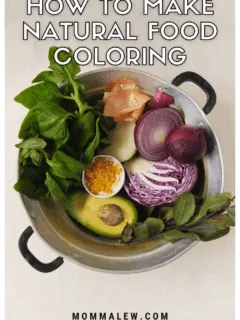Here’s everything you need to know about ways to substitute artificial dyes for natural food coloring. Fruits, vegetables and spices are all natural colorants that you can use in your baking and recipes.
When it comes to decorating cakes and cookies, many people rely on food coloring to add a splash of color.
However, traditional food dye can be full of chemicals and artificial ingredients. If you’re looking for a more natural option, there are several ways to make your own food coloring at home. One simple way is to use fruit and vegetable juices.
Our journey to avoid food dyes began many years ago when my daughter was just about 3 years old. You should read our story about my daughter’s allergic reactions to synthetic food dyes.
There are plenty of ways to make natural colorings at home with common ingredients.

One option is to use vegetable and fruit juice. For example, carrots can be juiced to produce a beautiful orange hue, while blueberries will yield a lovely blue shade. You can also experiment with other foods like coffee, tea, or even spinach.
Another way to make natural food coloring is by using spices. Turmeric, for instance, will impart a yellow or orange tint, while paprika can be used to achieve a deep red color or pink color.
For something truly unique, why not try activated charcoal? Just be warned that it will probably turn everything it comes into contact with black!
For green food coloring, you can try using matcha powder or spirulina. Or, for a bright blue hue, try using butterfly pea flowers or blue majik powder.
And there’s no need to limit yourself to just one color – you can mix and match natural food coloring to create any shade you desire.
It’s amazing how beautiful and colorful food can be thanks to using your own natural food dye! The next time you’re looking to add a little color to your food, ditch the artificial food coloring and reach for one of these natural alternatives instead.

Things to keep in mind when using a natural food colorant for Best Results
While artificial colors are made to have no flavor, homemade food coloring is full of flavor that can change your recipe.
Also, a natural sources for food coloring won’t have the same amount of brightness as food dye. A natural substitute will be in different shades.
Use small amounts of each coloring. These are foods after all and since they are being juiced, their tastes will be strong! Start out with a little bit at a time, 1 tsp to start, as you can always add more as needed.
Just be sure to mix the natural food coloring thoroughly into the food so that the color is evenly distributed.
DIY Food Colorings
You can buy freeze dried fruits that you make into a fine powder and use as natural dyes by using a
food processor and a cup of water. Or you can make liquid dyes through vegetable and fruit juices or purees. Make your own juices and purees in a food processor, using an immersion blender or a blender.
Here are some of our favorite natural alternatives!
Red Dye
Raspberries, Pure Beet Juice, Beet root powder, pure pomegranate juice, cranberry juice, tomatoes, cherries, red cabbage
Pink
raspberries, strawberries
Orange
Pumpkin, Carrot Juice, carrot powder, sweet potatoes, paprika
Yellow
Turmeric powder, saffron flowers, butternut squash
Green Dyes
A little Spinach or Kale Juice, matcha powder
Blue
Blueberries, blueberry juice
Purple Dye
Purple Potatoes, Blackberries
Brown
Coffee, tea, cocoa powder
Black

Check out these delicious recipes using natural food colors:
- Beetroot Chocolate Cake with Dark Chocolate Ganache
- Red Velvet Cake with cream cheese frosting
- Ice Cream in Different Colors
- How to Dye Easter Eggs with natural ingredients
How long do these natural food dyes last?
You can keep your food dye substitutes in the refrigerator in an airtight container for about 2 weeks.


Tammy
Monday 13th of December 2021
When baking I bake from scratch,not using box mix that do always know actually what in it.
Brandon Omalley
Saturday 4th of December 2021
I'm gonna try the red and green!!!
julissa
Tuesday 2nd of March 2021
good ideas
Recipes for Kids: Slime, Paint, Play dough, Soap, and More | I AM My Best
Tuesday 31st of March 2020
[…] https://www.mommalew.com/16-natural-food-dye-alternatives/ […]
Activities to Keep Kids Active When Schools Close- Day 3 | I AM My Best
Wednesday 18th of March 2020
[…] 16 NATURAL FOOD DYE ALTERNATIVES […]